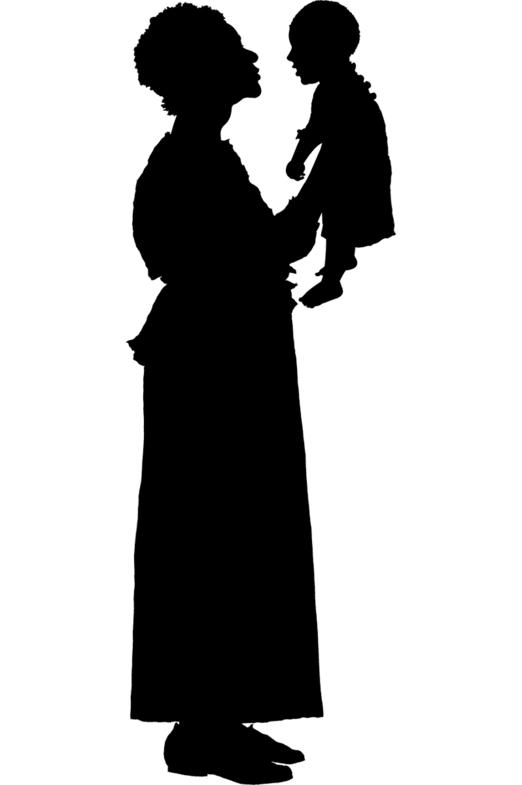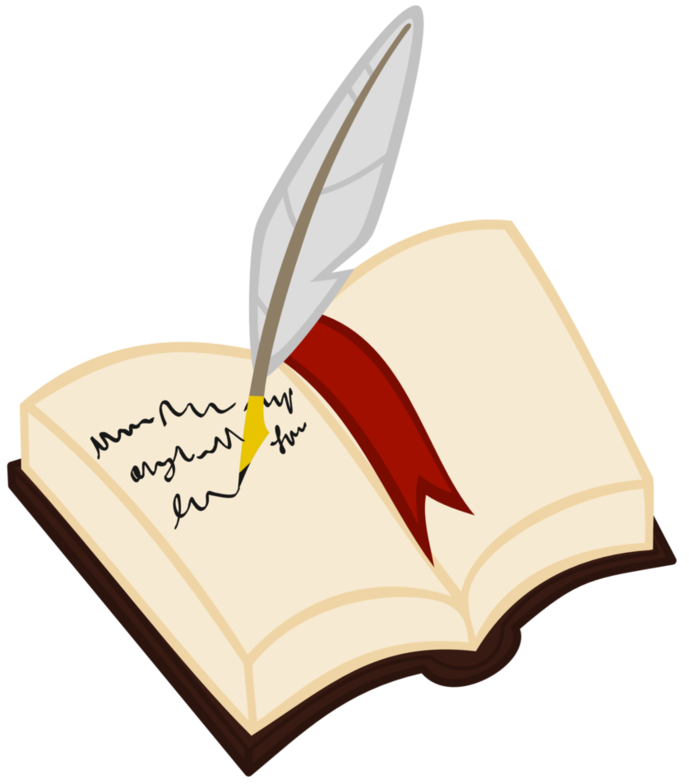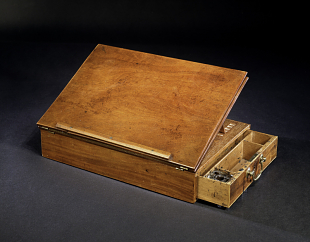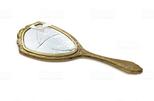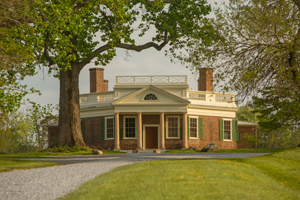SoulsinMyFamily.org
It was a hot summer day at Monticello, just like most summer days in Virginia. Mulberry Row, the plantation street, was usually a busy, noisy place with the clang of the blacksmith's hammer, the chatter of the slave children going about their chores and the talk of the cooks in the kitchen under the South Terrace.
But on this day Mulberry Row must have been silent. The talk of the slaves was hushed and the only noise of any labor was coming from the joinery, way down at the end of the plantation street. John Hemings, head carpenter and cabinetmaker had a final project to complete for his master. John had the sad duty of building Mr. Jefferson's coffin.
John Hemings was born at Monticello in April, 1776, the fifth son of Betty Hemings, the head of the Hemings family. His father may have been Joseph Neilson, one of the white workmen hired to build Mr. Jefferson's fine house.
By the age of nineteen John was listed as a carpenter in Mr. Jefferson's Farm Book and three years later he was working as an apprentice to Davy Watson, the joiner. When James Dinsmore, an Irish joiner, arrived to work on the interior woodwork in the new house, "Johnny" was assigned to learn more skills under his direction.
When the house was completed in 1809, Mr. Dinsmore moved on to other work and John Hemings was placed in charge of the joinery on Mulberry Row.
July 4, 1826
Mulberry Row, Monticello
Taking Charge of the Shop
From that time on Johnny became one of the most skilled and well rewarded slaves of the Monticello plantation community. He was also a favorite of Mr. Jefferson's grandchildren - they called him "Daddy Hemings". His wife Priscilla served as their nurse. The grandchildren called her "Aunt Priscilla" and she was owned by their father, Thomas Mann Randolph.
John's skills were of such high quality that he made several pieces of furniture for the house - some still on display there today.
Working at the Forest
Mr. Jefferson had such confidence in John's talent and work habits that he was sent to do repair work at Poplar Forest, the Jefferson retreat in Bedford County. These visits often lasted for months and since (unlike most slaves of his day) John could read and write, he and his master exchanged letters.
Perhaps John was taught to read by Cornelia Randolph. While staying at Poplar Forest in 1816, she requested a favor of her sister, Virginia, back home:
"...I left several things at Monticello which I intended to have brought, & which I wish you would send by papa if he comes...There is a little English dictionary which mama gave me some time ago,...I intended to give it to Daddy but could not bring it with me, it is very small & if papa or brother Jeff can bring it I wish you would send it..." (1)
Letters to Mr. Jefferson
Mr. Jefferson received bad news from John while he was working at Poplar Forest in the fall of 1819. He wrote:
"Dear sir i am veary sorrowey to inform you that the flat roof over the hall Lakes veary bad Wensday 22th we had a raine for 24 ourers cleard off on Thursday at son rise and naver stop driping untill 10 o Clock in the day...all had better Stand until you coms i am your obedient sirvent" (2)
By December that same year John had finished his work and was more than anxious to return home to Monticello. Mr. Jefferson told him a cart would be sent to bring him home when he was ready so John responded:
"...ef Possible i expect to get Don on the 11th Sunday which is 12th i should be Puting evry thing a way & Pacting up my things i should be ready for starting on monday at Day Light..." (3)
Even Joel Yancey, the Poplar Forest overseer, was aware that John was ready to go home. He wrote to Mr. Jefferson:
"...Johny Hemings is expecting to day, every hour, that a messenger will arrive for him, and I write to day as he may not be a moment detaind, when you send for him as \he/ appears so anxious to get off..." (4)
John certainly deserved a trip home to see Priscilla at Christmas. They had been separated for several months when he was sent to Bedford.
To The Forest Again
A few years later (1821) John Hemings was at Poplar Forest once more and he took advantage of his correspondence with his master to complain about another slave:
"Dear Sir I am sorry to complain to you so near the close of my worck above all things on earth I hate complants but I am bliged...the very moment your back is turnd from the Place nace takes every thing, out of the garden and carries them to his cabin and bury's them in the ground...the pipel [Poplar Forest slaves] tells me that he makes market of them at the first oppertunity." (5)
Queries...
Why didn't John tell the overseer about Nace's stealing?
John probably meant Nace put the food in a root cellar. What is a root cellar?
Whose garden was he stealing from?
What does John mean by "makes market"?
The Writing Box
In 1825, Ellen Randolph, one of Mr. Jefferson's granddaughters married Joseph Coolidge, a gentleman from Boston. For a wedding gift, Mr. Jefferson directed John Hemings to build Ellen a ladies writing desk. The desk, along with her other belongings was sent by boat to Boston. The ship was lost at sea - and along with it - all of Ellen's things. Her Grandpapa wrote to her of a replacement for the desk:
" We have heard of the loss of your baggage,...John Hemmings was the first who brought me the news...that beautiful writing desk he had taken so much pains to make for you!...I asked him if he could not replace it by making another? No. his eye sight had failed him too much...it has occurred to me however that I can replace it...by a substitute...surely a connection with the great Charter of our Independence may give a value...now I happen still to possess the "writing box" on which it was written. it was made from a \drawing/of my own, by Ben Randall, a cabinet maker in whose house I took my first lodgings on my arrival in Philadelphia in May, 1776. and I have used it ever since. it claims no merit of particular beauty. it is plain, neat, convenient..."(6)
The gift from Grandpapa was the plain writing box on which Mr. Jefferson wrote the Declaration of Independence. Today that desk, preserved by the Coolidge family, is exhibited in the Smithsonian Institution.
Queries: Did Mr. Jefferson realize how important his desk would be in the future?
What does the desk represent to Americans today?
The First Rate Workman
Through the years, John Hemings skill as a joiner and cabinetmaker contributed to the making of special furniture and woodwork at Monticello. Mr. Jefferson grew to rely on John's skills.
In his old age, Mr. Jefferson suffered greatly from rheumatism and liked to sit in his Campeachy chair - which gave his legs relief while reclining. He had an attack of rheumatism while at Poplar Forest and wrote to his daughter Martha:
"I am much recovered from my rheumatism, altho' the swellings are not erntirely abated, more the pains quite ceased. it has been the most serious attack of that disease I ever had. I longed for a Siesta chair...I must therefore pray you to send by Henry the one made by Johnny Hemings...\Wormly/ should wrap it well with a straw rope, and then \bowed/ up in a blanket..." (7 )
Johnny's eyesight had been failing over the years as he claimed. In 1822, Mr. Jefferson noted in his Memorandum Book:
"Nov. 6. Pd. Elijah Brown spectacles for J. Hemings 1.D..." ( 8 )
At the Forest with Grandpapa
Mr. Jefferson often allowed some of his grandchildren to accompany him to Poplar Forest. During that busy summer of 1819, Ellen was with him when she wrote home to her sister Virginia with a message from John to his wife Priscilla:
"John Hemmings begged it of me as a very particular favor to 'give his news to Aunt Priscilla' to say he was doing well but mighty tired of the Forest and wished himself at home. any message that she may send him it will give me great pleasure to receive from you - for Johnny is one of my prime favorites and more so, now than ever since I have witnessed his kind attentions to Burwell." (9)
NOTE: See story on Burwell Colbert, who was very sick while at Poplar Forest that summer.
Praise from Mr. Bacon
The woodworking skills of John Hemings were well known on the plantation. Many years later, when asked his memories of working at Monticello, the overseer Edmund Bacon praised John for his fine work:
"John Hemings was a carpenter. He was a first-rate workman - a very extra workman. He could make anything that was wanted in woodwork. He learned his trade of Dinsmore. He made most of the woodwork of Mr. Jefferson's fine carriage." (12)
Mr. Bacon also remembered John building the boxes to ship Mr. Jefferson's books to Washington - these books would be used to start the new Library of Congress.
"Mr. Jefferson had a very large library... He directed me to have it packed in boxes and sent to Washington. John Hemings, one of his servants, made the boxes, and Burwell (Colbert) and I packed them up mostly." (13)
A Letter to Septimia
Again in 1825 John Hemings was back at Poplar Forest to do roof repairs. By this time Francis Eppes, a grandson, owned the house which had been damaged by fire. Mr. Jefferson wrote:
"We heard some time ago indirectly & indistinctly thro' your friends at Ashton of the injury sustained by your house at P. F. and I have waited in hopes you \would/ inform me of the particulars that I might know how \far/ I can help you. I will spare J. Hem. to you & his two aids and he can repair every thing of wood as well or perhaps better than any body there." (10 )
In August John was still at Poplar Forest ( he had been there since early Spring) and he wrote to Septimia, his masters youngest granddaughter:
"your Letter came to me on the 23th and hapey was I to embreas it to see you take it upon you self to writ to me and Let me know how your grand Pare was Glad am i to hear he is no worst dear I hope you ar well and all the famely give my Love to all your brothars Gorge with (George Wythe Randolph) speculy... I am in hops I Shol be able to Com home by the 25 of November Ef Life Last" (11)
Rewards for Hard Work
Along with Burwell Colbert, the butler, John Hemings was paid a yearly gratuity ( a tip) or what Mr. Jefferson called an "encouragement". This note was entered in his Memorandum Book in April, 1811:
"Apr. 11.Gave John Hemings 15.D. to wit the wages of one month in the year which I allow him as an encouragement." (14)
These yearly payments continued until Mr. Jefferson's death in 1826.
Beginning in 1819, John also received a special clothing allowance at a store in Charlottesville. He would no longer be issued the same clothes as the other Monticello slaves. He made note in the book:
"Mar. 6. Gave John Hemings an order on Jas. Leitch for 20.D. Cash his annual gratuity & for clothes to the amount of 12.D. instead of his annual clothing." ( 15)
Queries
How did John Hemings feel about Mr. Jefferson's grandchildren?
Why did John require special clothing?
Saying Goodbye to Ol'Master
So John Hemings was a very special workman -so skilled that Mr. Jefferson chose to reward him with clothes and money. But on July 4, 1826, John was working in the joinery on Mulberry Row completing one final need - he was building a coffin for his master.
John was one of five slaves freed in Mr. Jefferson's will. He was also awarded tools to practice his trade (so he could support himself) and provided a cabin somewhere on Jefferson land. The Jefferson grandchildren, so fond of "Daddy Hemings", remained in contact with John and Priscilla after their grandfather's death, even when they no longer lived on the mountain.
In 1830 John was grieving again - this time for Priscilla. Cornelia wrote to Ellen of Priscilla's sickness and death:
"...she had been complaining of head ach several days...he read prayers to her & they went to bed; during the night she groaned & he asked her if she was worse she said no but that her head ached a great deal; she told him also to look under the looking glass & he would find something he would care for...being uneasy he soon awoke & shaking her found she was dead...she was stiff & cold..." ( 16)
A Marker for Priscilla
On a visit to the mountaintop in August, 1831 Cornelia found John Hemings busy at work again - this time carving a tombstone for Priscilla's grave. The slaves spoke of how John still dwelled on Priscilla's death - how he talked of it over and over. Cornelia had written to Ellen:
"...some days after (her death) recollecting that she had told him to look under the glass he did so & found a bundle containing a black cravat, crape hat band & a lock of her hair. Should we ever visit Monticello again, her loss will cause a painful addition to the feeling of loneliness & desertion we shall experience there; finding our old servants about us when we went there it did seem something like home, but when they are gone...it will be deserted indeed." (17)
Many years have passed since John and Priscilla Hemings lived at Monticello. It is difficult to imagine what their lives were really like as slaves. But the beautiful furniture and woodwork in Mr. Jefferson's house remind us of the dedicated work and skill of slaves like John Hemings - " a first rate workman".
More Queries...
Did Priscilla know she was dying?
How did the Randolph children feel about her death?
Why did she leave the cravat and hatband for John?
Sources
(1) Cornelia Randolph to Virginia Randolph, October 25, 1816, Family Letters Project
(2) John Hemings to Thomas Jefferson, September 26, 1819, Founders Online.
(3) John Hemings to Thomas Jefferson, December 2, 1819, Founders Online.
(4) Joel Yancey to Thomas Jefferson, December 12, 1819, Founders Online.
(5) John Hemings to Thomas Jefferson, November 29, 1821, Founders Online.
(6) Thomas Jefferson to Ellen Randolph Coolidge, November 14, 1825, Founders Online
(7) Thomas Jefferson to Martha Jefferson Randolph, August 24, 1819, Founders Online
(8) Memorandum Book, November 6, 1822, page 1391, Founders Online.
(9) Ellen Randolph to Virginia Randolph, August 4, 1819, Family Letters Project.
(10) Thomas Jefferson to Francis Eppes, February 17, 1825, Founders Online.
(11) John Hemings to Septimia Randolph, August 28, 1825, Family Letters Project.
(12) Jefferson at Monticello, Bear,The Private Life of Jefferson,page 101.
(13) Jefferson at Monticello, Bear, The Private Life of Jefferson, page 108-109.
(14) Memorandum Book, April 11, 1811, page 1265, Founders Online.
.
(15) Memorandum book, March 6, 1819, page 1352, Founders Online.
(16) Cornelia Randolph to Ellen Randolph Coolidge, May 30, 1830, Family Letters Project.
(17) Ibid.
John Hemmings
"A First Rate Workman"
